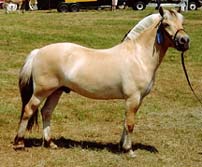

Fjord


Introduction: If you have any comments or suggestions, please click here. This was the horse of the Vikings.
Names: Fjord, Norwegian Fjord, Norwegian Fjord Horse, Fjord Pony, Fjording. I will use the shortest form. Sometimes called the Westland or the Vestland Horse (the latter probably being simply the correct pronunciation of the former, knowing the Teutonic languages!).
Origin: Comes from Norway. The ponies of the Vikings were on the scene long before the Vikings appeared, and they are believed to have been bred in North Europe some 2000 years B.C. Reared particularly in the Federal German Republic for small farmers.
Breeding: Admixture of Arab blood to the native breed (which resembled most of the primitive native breeds, e.g. Equus przewalskii przewalskii Poljakoff and Equus przewalskii gmelini) has turned the Fjord Pony into a fixed breed. Nowadays, pure-bred.
Description: Even today, they look much like their forebears of the Ice Age. Bears a striking resemblance to the Asian Wild Horse.
Action: Exceptionally surefooted; excellent walk, and fine trotting action covering much ground.
Body: Neck short and thick-set. Low withers. Back short and narrow, frequently sway-backed, good barrel. Quarters short and sharply oblique; all muscles rather poor. Shoulders often short and steep.
Color: Yellow dun, with black and silver mane and tail. Black dorsal stripe. Generally a dun or blue-dun with black dorsal stripe, black legs and black and white mixture in tail and mane.
Head: Rather angular, which reminds one distantly of the Arab. Usually rather large yet is always clean-cut; broad forehead; short, rather broadly placed ears. Protruding eyelids, large expressive eyes. Wide nostrils.
Hair: Noted for a coarse erect mane, usually clipped to give the neck a pronounced crest.
Legs: Close together (narrow) but hard and clean, with clearly marked and powerful tendons and joints.
Size: 13-14.2 hands. 13.1 to 14.1 hands.
Temperament: It has a deserved reputation for sense and good temper. Good-natured, cheerful character and keen temperament.
Features: Hardy. Small, economical and primitive breed of horse, standing on the borderline between "heavy" horse and pony; surprisingly tough and easily fed; amazing tractive power; tireless; robust constitution. Sturdy.
Uses: Good all round worker--used for riding, driving, hauling and carrying. Many European countries find Fjord ponies indispensable for all kinds of land and farm work. Particularly favoured as light harness horse and children's pony, for which it is not entirely suitable as it is extremely broad.
Accomplishments:
Curiosities: The Vikings were keen horsemen, but they did not confine their activities to riding. Horse fighting was a popular sport, and as with many Scandinavian and Teutonic peoples, the sacrifice of white horses was considered essential for placating the gods.
Profiles:
Conclusion: